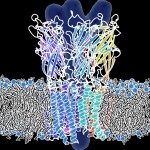Link to Pubmed [PMID] – 19917292
Link to HAL – Click here
Link to DOI – 10.1016/j.jmb.2009.11.024
J. Mol. Biol. 2010 Feb;395(5):1114-27
The crystal structure of the extracellular domain (ECD) of the pentameric ligand-gated ion-channel from Gloeobacter violaceus (GLIC) was solved at neutral pH at 2.3 A resolution in two crystal forms, showing a surprising hexameric quaternary structure with a 6-fold axis replacing the expected 5-fold axis. While each subunit retains the usual beta-sandwich immunoglobulin-like fold, small deviations from the whole GLIC structure indicate zones of differential flexibility. The changes in interface between two adjacent subunits in the pentamer and the hexamer can be described in a downward translation by one inter-strand distance and a global rotation of the second subunit, using the first one for superposition. While global characteristics of the interface, such as the buried accessible surface area, do not change very much, most of the atom-atom interactions are rearranged. It thus appears that the transmembrane domain is necessary for the proper oligomeric assembly of GLIC and that there is an intrinsic plasticity or polymorphism in possible subunit-subunit interfaces at the ECD level, the latter behaving as a monomer in solution. Possible functional implications of these novel structural data are discussed in the context of the allosteric transition of this family of proteins. In addition, we propose a novel way to quantify elastic energy stored in the interface between subunits, which indicates a tenser interface for the open form than for the closed form (rest state). The hexameric or pentameric forms of the ECD have a similar negative curvature in their subunit-subunit interface, while acetylcholine binding proteins have a smaller and positive curvature that increases from the apo to the holo form.





